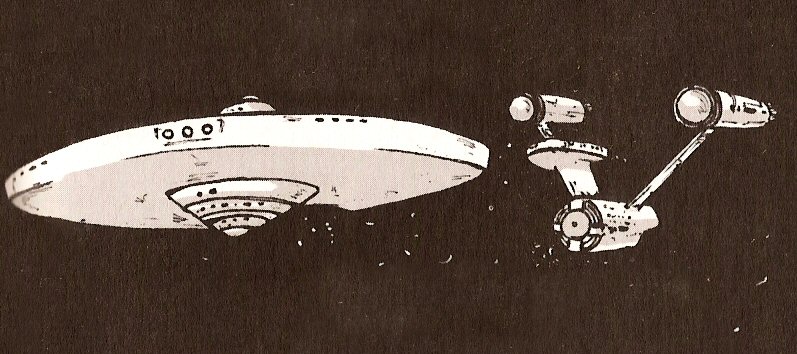The Enterprise-D was capable of saucer separation.
Was this true of any other Enterprises, e.g. the original?
The Enterprise-D was capable of saucer separation.
Was this true of any other Enterprises, e.g. the original?
Memory Alpha indicates that saucer separation was a capability of Constitution-class starships, but only as "a last-resort option".
There are two TOS episodes I know of where jettisoning the nacelles is mentioned: "The Apple" (cited in a comment from OghmaOsiris) and "The Savage Curtain".
From "The Apple" (script):
KIRK: Then use your imagination. Tie every ounce of power the ship has into the impulse engines. Discard the warp drive nacelles if you have to, and crack out of there with the main section, but get that ship out of there!
From "The Savage Curtain" (script):
KIRK: Scotty, inform Starfleet Command. Disengage nacelles, Jettison if possible. Mr. Spock, assist them. Advise and analyze.
Also, I don't know if it is considered canon, but the first volume of Star Trek: The Manga has the ship separate into two sections. However, they can't rejoin on their own:
"Captain's log, stardate 3378.7. Science Officer Spock reporting: The Enterprise is making its way to a rendezvous with technicians from Starbase 13, where the two sections of the ship will be rejoined."

Finally, I've heard that this capability has also be mentioned in works like The Making of Star Trek, the Star Fleet Technical Manual, and Mr. Scott's Guide to the Enterprise. However, I'm unable to confirm this with specific quotes, references, or technical schematics.
In a recent IDW Star Trek comic I, Enterprise PtII, we learn that not only can the saucer section of the (Kelvin) Enterprise be separated but that it can also be reattached if the separation sequence hasn't yet been completed.

We actually see this in Star Trek: Beyond
Yes. In one of the TOS episodes ("The Apple"), Kirk tells Scotty to "detach the saucer section if you have to" in order to escape the danger.
In Star Trek: Star Ships Collections, 1st issue, it says:
The Constitution-class USS Enterprise (NCC-1701), commanded by Captains Kirk and Pike, could also separate the saucer section from the rest of the ship, though the idea was that this would only be used to save the crew when the ship was in danger of being destroyed
Actually, in the new Star Trek: Beyond movie that just came out, the saucer was separated right before the ship actually got destroyed and crashed to the planet.
My speculation as to Trek tech began when I was 15 or so--43 years ago. The dialogue from "The Apple" has already been quoted, and The Making of 'Star Trek' cited, to wit: "Designed to operate separately from the rest of the ship, the saucer therefore contains all elements necessary for independent operation."
The latter would imply Kirk's ship's saucer to have been routine-detachable (like Picard's); the latter would imply otherwise. Using ONLY "episode data" -- and ignoring that presented in "Making" ONLY when it violates such -- AND taking into account ALL episode data, my personal belief is that while Kirk's saucer may not have been in fact "routine detachable," it was...nearly so, and by design, intended to have been so.
To clarify the latter (and to speculate that Constitution class ships alone, for some reason, lacked the 'routine' feature), one must bear in mind Scott's description of a ship Enterprise discovered when in the "pocket universe" entered via the Delta Triangle. To quote from "The Time Trap"--
"Captain, there's the old Bonaventure. She was the first ship to have warp drive installed. She vanished without a trace on her third voyage." (I could near-quote the line from memory, but copied it from source here).
I won't debate those who consider the Animation not to be "canon." Same cast, same Producer, many of the same writers... As to Bonaventure herself, she looked like this:
and was clearly so-drawn so that viewers of old (in some cases small, and on occasion still black-and-white) TVs could know WHICH ship Scott was talking about. She looked, in short, much like the Enterprise.
My point being: per his FIRST appearance, Zefram Cochrane did not "invent" the Warp Drive--he discovered the "space warp." THIS principle, applied to impulse propulsion (NOT a hydrogen-fusion system; can that make a ship go backwards?), permitted application of faster-than-light speed. LATER, the Warp Drive was "installed" "aboard" Bonaventure by means of the addition of an underslung engineering hull and its twin Warp nacelles.
Yes, starships have routine-detachable saucers: hyperlight-impulse-driven saucers. Most saucers can land (Kirk's had what looked like triangular landing pads on the saucer's underside; David Kimble's cutaway of the Motion Picture refit showed its square pads, and TMP's blueprint set labeled them as such. Picard's saucer crashed due the nearby explosion's EMP (which if shielded against it would have weathered intact).
That impulse IS hyperlight is "proven" by dialogue and action in the 1960s Trek, several of the films, and various Next Generation episodes. How fast is maximum impulse? We know per E's arrival at Regula prior its victims' rigor mortis when denied it five hours out, and per Geordi's "Aye, sir, full impulse" (or maybe it's "Aye sir, warp six"--I'm lazy; go check the transcripts) in the teaser of "Conspiracy."
IF undamaged, starship saucers can hit Warp Six, land and take off repeatedly, and otherwise "operate separately." Could the original Connies' saucers do that? Dialogue in "The Apple" would seem to imply otherwise, but I wonder...